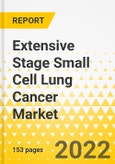Treatment directed toward decreasing the chemotherapy-induced toxic effects
This report comes with 10% free customization, enabling you to add data that meets your specific business needs.
Extensive stage small cell lung cancer is extremely aggressive sub-type of small cell lung cancer. Small cell lung itself is a sub-type of lung cancer which accounts for less than 20% cases. The treatment of extensive stage small cell lung cancer has been extremely challenging owing to poor survival rate of the patients. The median overall survival reported among the extensive stage small cell lung cancer patients has been slightly above a year while the overall progression free survival is reported to be of six months. Before the emergence of immune checkpoint inhibitors, traditional chemotherapy which included etoposide in combination with platinum (cisplatin or carboplatin) were the treatment mainstay however since the approval of immune checkpoint inhibitors; these have been included in the standard treatment regimen along with chemotherapy.
The Growing Prevalence of Extensive Stage Small Cell Lung Cnacer
The prevalence of extensive stage small lung cancer is estimated to increase in five of the seven major markets included in the study. Geographically, the U.S. remains at the top with an estimated prevalence for 2021 of more than 47,000 patients followed by the U.K. with over 8,500 patients. The prevalence is forecasted to be growing at a CAGR of 2.61% and 1.61% respectively for the U.S. and the U.K for the period 2022-2032.
Competitive Landscape
The current global extensive stage small cell lung cancer market has two approved immune checkpoint inhibitors namely Imfinzi (Durvalumab) from AstraZeneca PLC and Tecentriq (Atezolizumab) from F. Hoffmann La-Roche Ltd. Zepzelca (Lurbinectedine) from Jazz Pharmaceuticals Plc and Cosela (Trilaciclib) from G1 Therapeutics Inc. are other two products approved for the treatment of extensive stage small cell lung cancer patients.
Since, the introduction of immune checkpoint inhibitors to the extensive stage small cell lung cancer treatment, the competition in the global extensive stage small cell lung cancer market has significantly increased. F. Hoffmann La-Roche Ltd. and AstraZeneca Plc are the leading players among the companies having immune checkpoint inhibitor portfolio in the global extensive stage small cell lung cancer market. The companies having immune checkpoint inhibitors under clinical development have also added extensive stage small cell lung cancer treatment to their portfolio.
Currently there are four products available in the market which are patented. The chemotherapeutic products which constituted the standard of care have all become generic. There is a rich clinical pipeline of extensive stage small cell lung cancer maket with dominance of immune checkpoint inhibitors along with bispecific antibodies.
Segmentation:
Within the research report, the segmentation has made on the basis of:
- Existing as well as Expected competition in the global extensive stage small cell lung cancer market. Commercial and Clinical products constitute “Products” segment., and
- Region is the other segment which covers the seven major markets (the U.S., the U.K., Germany, France, Italy, Spain, and Japan).
Demand - Drivers and Challenges
Some of the potential drivers identified by BIS Research includes:
- Potential therapeutic effects of immune checkpoint inhibitors in improving overall survival among cancer patients
- Treatment directed toward decreasing the chemotherapy induced toxic effects
There are some challenges identified for the global extensive stage small cell lung cancer market include; treatment related toxic effects, lack of effective diagnostic tools/methods among others.
How can this report add value to an organization?
Product/Innovation Strategy: The report provides an insight into estimated patient population eligible to receive treatment in the seven major market, with a view where the disease is on a decline and where it is showing an increasing trend. Additionally, the report provides an exhaustive list of pipeline products along with their developmental details which are currently in the development for extensive stage small cell lung cancer treatment. This can help organizations in assess the research activities, potential candidates to enter first into the market as well it can help the organization to assess where should they place themselves in order to get maximum benefit.
Growth/Marketing Strategy: The several growth strategies identified in the report include increased focus toward development of immunotherapies, use of immunotherapies in combination with existing standard treatment options, expanding the market reach by entering into licensing agreement with potential players.
Competitive Strategy: Key players in the global extensive stage small cell lung cancer market were analyzed and profiled in the study, who have commercially available treatment for extensive stage small cell lung cancer. Moreover, a detailed competitive benchmarking of the players operating in the global extensive stage small cell lung cancer market has been included to help the reader understand how players stand against each other, presenting a clear market landscape. Additionally, comprehensive competitive strategies such as partnerships, agreements, and collaborations will aid the reader in understanding the untapped revenue pockets in the market.
Key Companies Profiled
- F. Hoffmann-La Roche Ltd
- AstraZeneca PLC
- Jazz Pharmaceuticals Plc
- G1 Therapeutics Inc.
- Shanghai Henlius Biotech, Inc.
- Lee's Pharmaceutical Limited
- Jiangsu Hengrui Pharmaceuticals Co., Ltd.
- Beigene Ltd.
Table of Contents
Samples

LOADING...
Companies Mentioned
- F. Hoffmann-La Roche Ltd
- AstraZeneca PLC
- Jazz Pharmaceuticals Plc
- G1 Therapeutics Inc.
- Shanghai Henlius Biotech, Inc.
- Lee's Pharmaceutical Limited
- Jiangsu Hengrui Pharmaceuticals Co., Ltd.
- Beigene Ltd.








